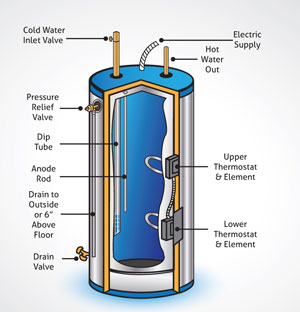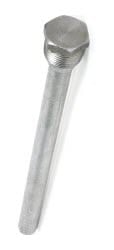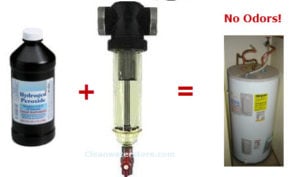what causes deep well water to start smelling
 Water containing hydrogen sulfide gas ("H2S") has a distinctive "rotten egg" aroma, which may be specially noticeable when running hot water.
Water containing hydrogen sulfide gas ("H2S") has a distinctive "rotten egg" aroma, which may be specially noticeable when running hot water.
Such water can discolor java, tea, and other beverages and alter the advent and taste of cooked foods. Hydrogen sulfide ("H2S") gas is a nuisance that is non unremarkably a health take a chance at concentrations typically found in household h2o.
Hydrogen sulfide can be toxic. Usually, the gas can be detected long before it reaches harmful concentrations. H2S is flammable and poisonous. While such concentrations are not typical, if gases are released in a confined area, they could cause nausea, affliction, and in extreme cases, death.
H2S dissolved in water tin can corrode plumbing metals, such as iron, steel, copper, and brass, and exposed metal parts in washing machines and other water-using appliances.
The corrosion of fe and steel from hydrogen sulfide forms ferrous sulfide or "blackness water," which can darken silverware and discolor copper and brass utensils. Hydrogen sulfide tin can also interfere with the effectiveness of water softeners and filter systems.
Sources of Hydrogen Sulfide
Iron bacteria and sulfur bacteria present in groundwater use iron and sulfur as an free energy source and chemically change sulfates to produce H2S gas. These bacteria utilise the sulfur available from decomposable plants, rocks, or soil and oftentimes thrive in an fe-rich environment.
The harmless, non-toxic leaner usually exist in oxygen-deficient environments, such every bit deep wells and plumbing systems. The bacteria do not usually cause health problems but contribute to bad tastes and odors at low levels.
The First Step is To Check For Odors in Cold & Hot H2o

Run a hose bib or tap as shut to the well equally possible and fill a 5- gallon bucket or other container and observe if at that place are odors. If you lot odor a "rotten-egg" odor, this is hydrogen sulfide gas.
If the h2o smells like oil or asphalt, this can be from manganese. As well, if the water smells like cucumber or sewage, this is usually a issue of iron and sulfur bacteria.

Run the water hot h2o from each tap and notice an odor in hot water, not in the cold h2o. This indicates a problem with the water heater. Fe and sulfur bacteria can collaborate with the anode rod in water heaters, resulting in hydrogen sulfide gas only in hot water.
Changing the anode rod to an aluminum-zinc rod tin often solve this problem.
Information technology is recommended that y'all drain your water heater at least once per twelvemonth. This will flush out the sediment that may accumulate in the bottom and give you an idea of the sediment type and color, if whatever, are nowadays.
To learn more about odors and what may be causing them, visit our Odors page or read our guide on "How To Care for Sulfur Odors In Well H2o."
Sulfur odor in pipes after installing a new treatment organization?
If possible, we recommend adding a cup of bleach into the pipes after the new softener or whole business firm filter and flush the h2o heater and household common cold water pipes with some bleach to eliminate the odor.
1 thing that can happen with odors is that odors can still develop in the pipes because of bio-films while there is no odor leaving the new treatment system. This tin be worse in sections of the plumbing that are not used much.
Introducing a small amount of chlorine (laundry bleach is fine) and letting the water sit for a couple of hours helps sanitize the pipes and prevents the odors from developing in the pipes if that was a problem.
Water Heater Odor Only?
If the olfactory property is primarily in hot water, the water heater needs to be sanitized. Turn off water pressure to the water heater and Add together 1 cup of chlorine bleach to the water heater and turn the h2o back on.
If you have a prefilter housing, you tin add the bleach there. If not, remove the inlet flex pipe and bleed some water out of the water heater. Run hot water in the home for a infinitesimal to get chlorine bleach mixed into hot water and and so turn off the water. Let the water heater sit down for 2 hours and then run the hot water until articulate. Note this may have to exist repeated for severely fouled water heaters.
If the odor returns to the water heater, you may demand to remove or supplant the anode rod.
(Click here to learn more than about water scent.)
Sulfur Odors on Your Second Level or Upstairs Floors Just?
In some cases, it is worse on upper flooring levels because the gas can rise and appear out of fixtures on the upper floors.
The first step in eliminating this is to 'stupor chlorinate' the pipes. This is washed by calculation enough bleach to accomplish a 100 to 200 ppm chlorine residual and then allowing the chlorinated h2o to sit down in the pipes for
six to 8 hours or overnight.
If the odor or gasses go away but come up back in a few weeks, the stupor chlorination process is repeated.
There are various means to introduce chlorine bleach into pipes, but having a filter housing inline can make information technology easy.
With a spindown filter, yous can hands turn off the water to business firm, unscrew the filter and add chlorine bleach or peroxide.
-

Rut and Chemical Resistant Spindown Filter Makes it Easy to Add Bleach or Peroxide to Impale Your Odors in Pipes. Plow the h2o back on and flush your pipes until you lot smell bleach or meet bubbles from the peroxide.
- Permit it sit in pipes for several hours.
- Turn the water back on and flush the pipes.
- No more than odors!
Why Does My H2o Smell Similar Sewage?
If your common cold well water smells like sewage, it can be the result of several causes:
- Hydrogen sulfide from iron, sulfur or other types of bacteria naturally occurring in your well h2o
- Contaminated pipes with layers of bio-film caused by various types of iron, sulfur, or other types of leaner.
- Septic tank contamination
First, test your water for coliform bacteria using a lab kit or a exercise-information technology-yourself-at-home bacteria test kit.
Shock chlorinate and sanitize your well and pipage, and retest if the coliform test was positive.
Install a peroxide injection or chlorine injection system, or aeration with disinfection to eliminate bacteria.
If you notwithstanding accept questions, don't hesitate to e-mail u.s. at [email protected], leave us a message on Facebook, or utilize our online contact form for prompt, personalized assist from our trained professionals.
Thanks for reading!

Source: https://www.cleanwaterstore.com/blog/how-to-tell-if-odors-from-well-water-is-coming-from-well-or-inside-the-house/
0 Response to "what causes deep well water to start smelling"
Post a Comment